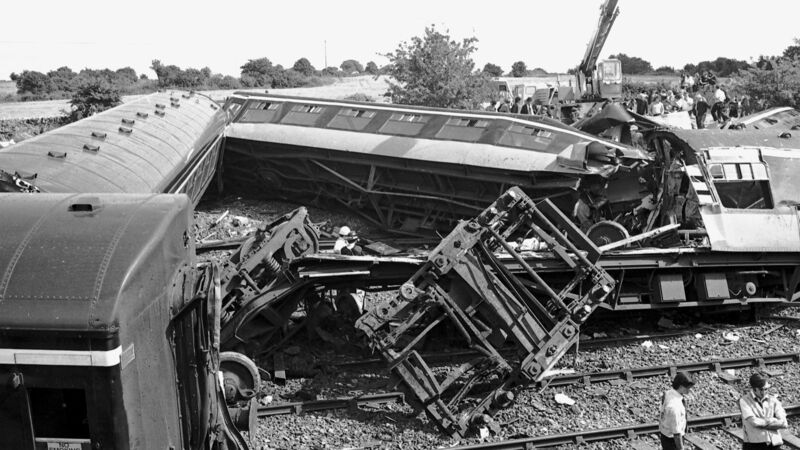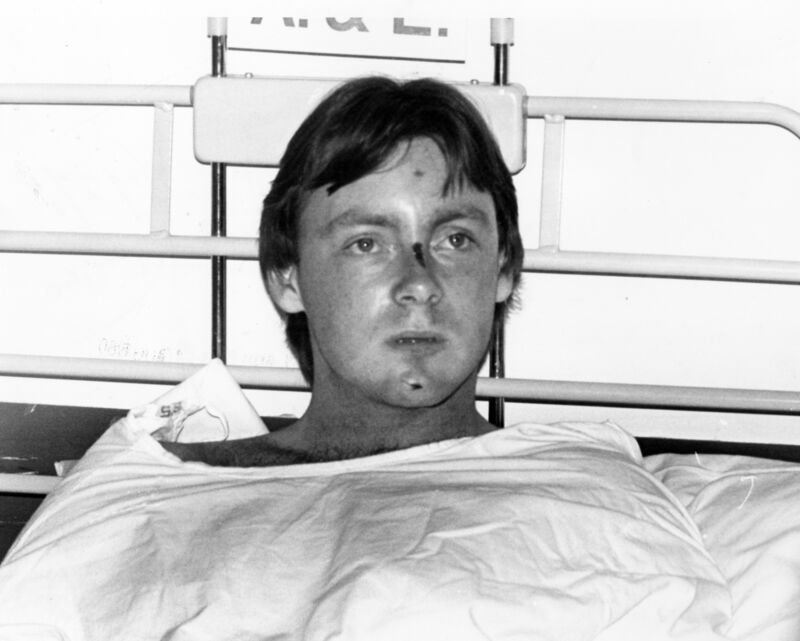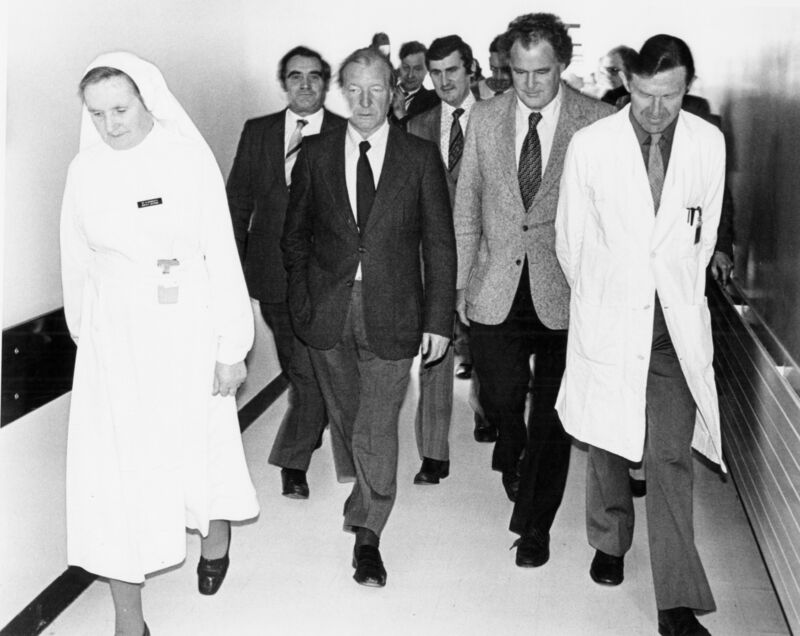How the Buttevant rail disaster changed lives forever

The Buttevant rail crash was the worst Irish rail disaster in modern times.
A major emergency plan was put into operation minutes after a passenger train travelling from Dublin to Cork crashed at Buttevant Railway Station at lunchtime on August 1, 1980.
The worst Irish rail disaster in modern times claimed 18 lives, injured nearly 70 others, and resulted in heroic responses from public and voluntary services.
Cork Regional Hospital (now CUH) activated its emergency plan after being alerted of the disaster at 12.55 pm by Mallow County Hospital, nine miles from the crash site.
As the first of 20 ambulances, and medical teams, reached the crash scene, six emergency operating theatres were prepared at the 600-bed Regional Hospital, which was immediately closed to visitors.
Two medical teams, each with a doctor and an anaesthetist, were also mobilised. One was sent to the crash site and the other to supplement the hospital staff at Mallow.
Convalescent patients at the Regional were sent home so that staff could cope with the casualties. Two offices were set up to deal with inquiries.
Nearly 200 staff including doctors and nurses moved swiftly and efficiently into action. Some who had been on holiday or on a day off came back on duty to help.
It was part of the Southern Health Board major accident plan which also involved the Gardai, the Defence Forces and other services and was regularly updated with twice-yearly drills.
Staff at the Regional awaited the arrival of casualties as emergency work continued at the crash site, and in the 98-bed Mallow Hospital, where many of the injured were being initially treated.
Each hospital linked information all day. As the first stage of the crisis ended, decisions were taken to transfer the seriously ill from Mallow to Cork for specialist treatment.

The Regional, now Cork University Hospital (CUH), had a full range of neuro-surgical and other facilities.
Professor C T Doyle said at the time: "We simply must pay tribute to the fantastic work done at Mallow Hospital and it was fortunate, indeed, that such a hospital existed within only a few miles of the accident scene."
At both hospitals, the accident and emergency departments worked at full stretch. One hospital worker said: "It is like the aftermath of a battle.” Southern Health Board chief executive Denis Dudley and Regional Hospital administrator Joe Martin, set up a liaison service for relatives of the dead and injured.
A team under county surgeon Archer Sunderland and county physician Michael Joyce provided vital services at Mallow to help control critical bleeding and respiratory problems.
Surgeon Peter Gaffney, one of seven consultants on duty, said at the time that the hospital played a key role as a resuscitation unit and ensured the more seriously injured were transferred alive.
While the life-saving efforts went ahead, a helicopter heading towards Buttevant on a flight path from Galway to Cork, passed over the crash site.
Irish Helicopters pilots Alan Mutton and Keith Greenwood touched down on a barely field near the rail track and took some of the injured passengers on board.
The helicopter, bearing the Papal insignia from Pope John Paul’s visit to Ireland the previous September, flew direct to the Regional Hospital.
A fleet of Southern Health Board ambulances, directed by Captain Brian Phelan were already bringing casualties to Mallow Hospital.
After briefing the authorities at the Regional on the extent of the disaster, the helicopter pilots started a five- hour shuttle service airlifting patients from Mallow to the Wilton complex.
The availability of a well-stocked blood bank, opened at the hospital four days earlier, had a critical part in the life saving efforts.
Matron Mary Coughlan compared the role of “The County” now part of the Cork University Hospital Group, to that of London hospitals during the wartime Blitz.

Bertie Walsh from Glanmire had been driving trains for eighteen years when he reported for work to C.I.E. at Inchicore in Dublin at nine o'clock on that Friday morning, the start of the August Bank Holiday weekend.
It was two or three minutes past ten o'clock when the 378 ton express, packed with 230 passengers, slowly moved out of Heuston Station for the journey south. It consisted of 11 coaches and a spare dining car.
But less than three hours later it lay in a tangled wreck across the main line track at Buttevant, almost 30 miles from its destination, Kent Station in Cork Most of the passengers who boarded the train in Dublin were holidaymakers. Some were on their way to spend the weekend with relatives. A few were business people anxious to fulfill appointments before the long weekend.
A couple of women knitted the time away. A baby in a carrycot dozed off to sleep and a priest walking through a carriage joked with two nuns about eating too much food.
Some passengers were having a meal in the dining car as the bar staff put up their counter shutters and began checking their stocks before the end of the journey.
The train's checker, Matt Blake, a member of Mallow Urban Council, went towards the first-class carriages. It was his fifty-seventh birthday. He was seriously injured but survived.
As the express continued towards non-stop Buttevant Station, three danger signals suddenly shot up on the side of the track. The train was about a quarter of a mile out and travelling at around 68 miles an hour.
Bertie Walsh shut off the power at once, applied the emergency brakes and kept sounding the warning hooter.

But it was too late. A tram travelling at that speed would need more than half a mile in which to stop. Loco class 075 was just eleven seconds from disaster.
Motorists waiting at the level crossing in Buttevant saw signalman Danny Joe O’Sullivan rush from his cabin and shout to a man on the track.
Pointsman Willie Joe Condon was making desperate efforts with an iron bar to close the track facing points which were open to a ballast siding.
The hooting train was 300 yards away and bearing down on him. He jumped clear moments before the loco shot over the points which diverted it into the siding and instant derailment.
Seconds earlier some of the passengers suspected something was wrong as they heard the prolonged hooting from the engine. Then the lights went out.
Luggage fell from the racks as the express wobbled. seemed to go sideways and in some of the forward carriages fall apart altogether.
People were hurtled from their seats as the re-routed train collided with an engine at the head of ballast wagons in the siding and ricocheted across the main line.
Some passengers died instantly from appalling injuries and heart attacks. Others lived for a while as they lay buried beneath tons of twisted steel and debris.
Most of the victims were in the first four carriages which were wrecked almost beyond belief. A dining car was ripped apart.
Yet, cans of Cola stayed upright on tables and a box of day-old chicks on their way to a West Cork housewife survived after being thrown clear in the impact.
John Tobin, the local GAA chairman, was on a chance lunchtime supervisory visit to the club's new community centre, half a mile from the Railway Station when he heard about the crash.
He immediately made the premises available as a medical and rest centre for shocked train passengers, most of whom were ferried there by local people in a fleet of cars.
Housewives and others abandoned their lunchtime chores and rushed to help. Kettles were boiled, meals and snacks arranged. Shocked passengers, some of them speaking broken English, were helped and comforted.

Other local people directed traffic outside the Railway Station pending the arrival of Garda reinforcements under Chief Supt. Pat Power, Inspector Pat McGill, and Sergeant Frank McDermott.
But the most inspiring work of all was at the crash scene as volunteers joined passengers and CIE workers in pulling wreckage apart with their bare hands in frantic efforts to reach trapped survivors.
Mallow-based Garda Peter Dooley, along with Det. Garda Fin O'Donoghue, was in the first patrol car to arrive and dramatically motivated the growing number of onlookers into helping.
John Shaw, an American soldier on his way to kiss the Blarney Stone and trace relatives, managed to free himself from the wreckage.
He went to help others whom he had photographed in their carriage minutes earlier, using a steel bar to lever off the heavy debrís. He was later awarded the United States Army Commendation Medal.
Bob Hartman, a Californian social welfare manager, and his wife Sharon, decided to have lunch in their carriage instead of in the dining car which was demolished in the impact.
A tall, bearded man, who once fell 300 feet down a glacier in Mexico, put his mountaineering strength to good use in the rescue operation.
Nurses and priests were among those who wormed their way into the darkness of the twisted carriages to bring aid and comfort to the dying and injured.
Civil Defence volunteers, whose training duties a few years earlier included a simulated train crash exercise, and members of the Red Cross and other bodies put their expertise to test.
Dermot O’Mahony provided earth moving machines to lay a makeshift road. Tons of limestone chippings were shifted to make way for two William O’Brien to help lift the wrecked carriages.

Taoiseach Charles Haughey broke his holiday in Kerry to visit the accident scene and the two hospitals. He praised the work of all the emergency services.
He extended the nation’s sympathy to the relatives of the 13 Irish, 3 English and 2 Austrians, who died, and wished those injured a speedy recovery.
Some of their recovered personal belongings were poignantly stored at the local Garda Station, where Sergeant Kevin Edwards, began his first week of duty in the town.
The items included a cowboy and Indian set that would never bring joy to some child, a broken guitar, and books with chapters still unread.
A subsequent public inquiry into the crash, which heard evidence from 56 witnesses during 13 days of hearings in Mallow blamed CIE for the accident.
It did not apportion blame to any individual directly involved in the operations which led to the derailment.
But it strongly criticised the company’s management, supervisory and practices and made several recommendations on railway operations.
The care and kindness extended to the families of those who died or were injured continued to be remembered for years afterwards. There are many examples.
Austrian brothers Bernhardt and Wernfried Zeiner presented a lantern to St Mary’s Church in Buttevant in memory of their parents, Albin and Maria Ann, who died in the crash.
A survivor, Donal Coughlan from Stanwell in Middlesex, wrote to the then Cork Examiner five months later:
“My thanks to the first aid personnel who removed me from the damaged coach; the shocked young priest who gave me his blessing; the ambulance crew and doctors that attended me, and the helicopter pilot and his companion who ferried me to the Regional Hospital.
“My thanks to the dedicated doctors and to the devoted nursing staff of the intensive care unit, whose care over a lengthy period enabled me to recover; my thanks to the staffs of other units that have continued the good work, and to the priests of the hospital.” On the 25th anniversary of the disaster, a committee in Buttevant, with the help of Irish Rail and Cork County Council, organised a commemorative day.
A five-foot tall bronze sculpture in the shape of two crossing train tracks, constructed at the Irish Rail works in Inchicore by Conor Murphy and inscribed with the victims’ names, was unveiled by Myra Woodworth, whose husband Bruce, from Rochestown in Cork, was killed in the crash.
Eighteen roses representing the victims were planted by the County Council. Terri O’Gorman, one of the organisers, said it was strongly felt there should be a focal point to which relatives of those who died or were injured could come to remember their loved ones.
It was a day of emotion, remembrance, and tears, but just as the ceremony was about to end, a beautiful multi-coloured butterfly, regarded by many as a symbol of hope and new beginnings, hovered briefly over the memorial.
And then it flew away in the sunshine towards the rail tracks where so much suffering, courage, compassion, and care was seen on that August day in 1980, when the lives of so many people were suddenly changed forever.









